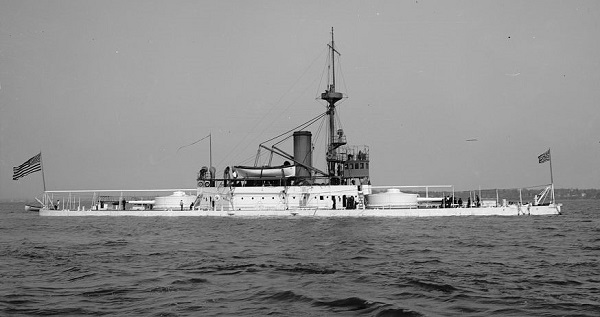


Construction of the new USS TERROR was done in fits and starts and was not completed until 1896, the vessel being commissioned on April 15. The reasons for the twenty-two year construction period are many-fold, however two main reasons were as follows.
First, the design of the ships of this class were constantly changed to unsuccessfully attempt to keep up with new technology. Also, the authorization bill funding the ship required that all parts be made in the United States, but the United States had no manufacturer capable of producing the armor for the vessel. Bethlehem Iron and steel eventually became the first domestic producer of this material as a result of the domestic materials stipulation in the authorization bill.
During the Spanish American War, the USS TERROR took part in the blockading of Cuba. One of the TERROR's crewmen, William Heany wrote home as the vessel operated off Cardenas as follows:
"Everything is running our way down here.
We are having a pretty hard time living on the government grub, but we
catch a prize every once in a while and
it keeps our spirits up, We got five ships up to date. Our first was a
two-masted schooner named AMANGO loaded with sugar. Our second was a
small steamer named AMBROZIO BOLIVAR, loaded with bananas and $5,000 in
gold coin. Our third was a big steamer, the GUIDO, loaded with general
cargo. She was built four years ago and cost 60,000 [British pounds]. A
two-masted schooner, the MARGARET, was our fourth prize, and out fifth
was a Swedish steamer loaded with coal for Matanzas. We sent her to Key
West…”
The Spanish vessels AMBROSIO BOLIVAR, and GUIDO, and the Cuban vessel ALMANSA (referred to as AMANGO, above) were all captured during the TERROR's first three days of blockading duty.
The USS TERROR took part in Admiral Sampson's abortive foray to locate the Spanish Fleet at Puerto Rico. Unfortunately, the USS TERROR suffered from repeated breakdowns, and was towed part of the way by the NEW YORK. She took part in the bombardment of San Juan, scoring some direct hits on the fortifications. She had fired thirty-one rounds.
After the War, the USS TERROR was decommissioned, but recommissioned in 1901 as a training vessel at the United States Naval Academy. She was decommissioned a final time on May 8, 1906. She was then used as a test hulk at the Naval Proving Grounds before being sold for scrap in 1921.
The USS TERROR was still afloat, unscrapped, into the 1920's, when she sunk near Shooter's Island, New York. She was apparently raised and scrapped in the early 1930's.
Vessels such as the USS TERROR had many drawbacks in their design. First, because of their low freeboard, monitors such as the USS TERROR were not particularly seaworthy.Their design did not have much reserve buoyancy - only about twenty percent in comparison with a about eighty percent for a "standard" vessel. This limitation meant that monitors were often used for harbor defense, not for sea warfare.
The design of the ship also resulted in excessive rolling, which made
it very difficult, if not impossible, to aim the guns on a target unless
in smooth waters. Again, this made monitors mainly effective in harbor
defense, not at sea.
| Classification: | Monitor #4 | |
|---|---|---|
| Keel Laid: | 1874 (rebuilt earlier vessel) | |
| Commissioned: | April 15, 1896 | |
| Rig: | One military mast | |
| Armament: | Four 10" Rifles | |
| Two 6-pounders | ||
| Two 3-pounders | ||
| Two Hotchkiss 1.65" rifles | ||
| Two 1-pounders | ||
| Two Gatling guns | ||
| One field gun (for landing parties) | ||
| Contractor: | William Cramp & Sons, Philadelphia, PA. | |
| Length: | 259 feet, 6 inches | |
| Beam: | 55 feet, 6 inches | |
| Mean draft: | 14 feet, 6 inches | |
| Max. draft fully loaded: | 15 feet, 4 inches | |
| Displacement: | 3,990 tons | |
| Complement: | 26 officers and 151 men, under the command of Captain Nicoll Ludlow | |
| Engine type: | Inclined compound engine generating 1600 hp. Twin screw. | |
| Boiler type: | 6 single ended cylindrical boilers. | |
| Speed: | 10.5 knots | |
| Coal bunker capacity: | 260 tons | |
| Normal coal supply: | 250 tons | |
| Coal endurance at 10 knots: | 1,300 nautical miles | |
| Armor: | 7" on sides, 1-3/4" on deck 11-1/2" on turrets. |
|
| Cost: | One of five ships that were to be completed from their various states of repair for $3,178,046 |
Harris, Lt. Cmdr. Brayton, The Age of the Battleship. (New York: Franklin Watts, Inc., 1965).
"Letter from the Terror," Brooklyn Times. May 11, 1898
(provided courtesy of James Haas)
Library of Congress - Photo of U.S.S. Terror
Naval History Department, Navy Department, Dictionary of American Naval Fighting Ships. (Washington DC: Government Printing Office, 1959).